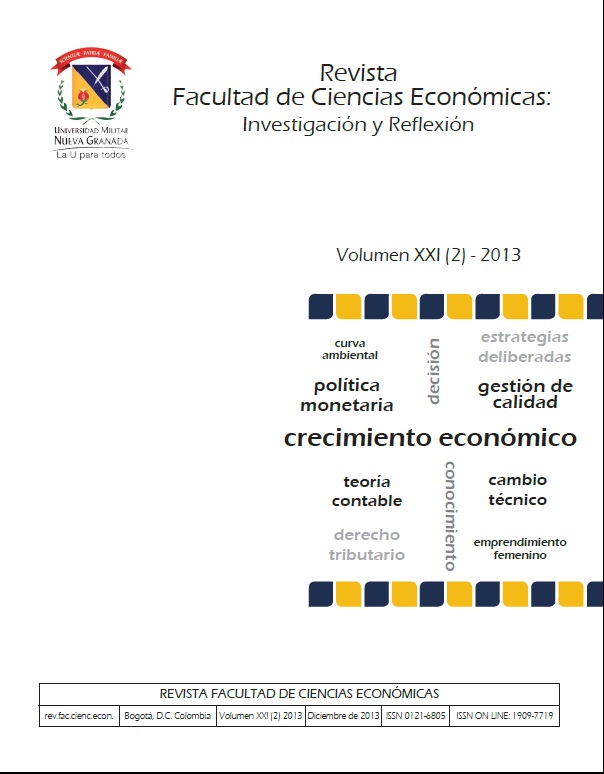The environmental Kuznets curve (EKC): an analysis landfilled solid waste in Colombia
Abstract
Environmental Kuznets Curve (EKC) hypothesis states that relation between environmental degradation and per capita income follows an upside down U path. This article aims to demonstrate EKC for Colombian case, using solid waste data from municipal landfills. The analysis is based on information from 707 towns during 2008 – 2011. Among main results there is evidence that supports the EKC hypothesis. This hypothesis is stable after controlling variables, such as population density and altitude above sea level. Results also show that inflection point is not homogeneous cross region.
Downloads
References
Andreoni, J. & Levinson, A. (2001)“The simple analytics of the environmental Kuznets curve”. In:Journal of Public Economics, 80(2):269-286.
Berrens, R., Bohara, A., Gawande, K. & Wang, P. (1997)“Testing the inverted-U hypothesis for US hazardous waste: An application of the generalized gamma model”. In: Economics Letters, 55(3):435-440.
Cole, M. (2004) “Trade, the pollution haven hypothesis and the environmental Kuznets curve: examining the linkages”. In: Ecological Economics, 48 (2004) 71– 81
Correa, F., Vasco, A. & Pérez, C. (2005) “La Curva Medioambiental de Kuznets: Evidencia Empírica para Colombia”. In: Semestre Económico, 8(15):13-30.
Dasgupta, S., Laplante, B., Wang, H. & Wheeler, D. (2002)“Confronting the environmental Kuznets curve”. In: The Journal of Economic Perspectives, 16(1):147-168.
Dinda, S. (2004) “Environmental Kuznets curve hypothesis: A survey”. In: Ecological Economics, 49(4):431-455.
Fernández, A. & Sánchez M. (2007) “Guía para la gestión integral de los residuos sólidos urbanos”. Organización de las Naciones Unidas para el Desarrollo Industrial (UNIDO). Available at: www.unido.org/fileadmin/import/72852_Gua_Gestin_Integral_de_RSU.pdf
Grossman, G. & Krueger, A. (1991) “Environmental impacts of a North American free trade agreement”. The National Bureau of Economic Research.NBER Working Paper No. 3914.Available at:http://www.nber.org/papers/w3914
Hoornweg, D. & Bhada-Tata, P. (2012)“What a waste: A global review of solid waste management”. World Bank.Urban Development Working Paper No. 15. Available at: http://go.worldbank.org/BCQEP0TMO0
Ichinose, D., Yamamoto, M. & Yoshida, Y. (2011) Reexamining the waste-income relationship”.GRIPS National Graduate Institute for Policy Studies. Discussion Paper No. 10-31. Available at: http://r-center.grips.ac.jp/gallery/docs/10-31.pdf
Johansen, S. (1988) “Statistical analysis of cointegration vectors”. In: Journal of Economic Dynamics and Control, 12:231–254
Johnstone, N. & Labonne, J. (2004)“Generation of household solid waste in OECD countries: An empirical analysis using macroeconomic data”. In: Land Economics, 80(4):529-538.
Mani, M. & Wheeler, D. (1998) “In search of pollution havens? Dirty industry in the world economy: 1960–1995”. In: Journal of Environment and Development, 7(3):215–247.
Mazzanti, M., Montini, A. & Zobolini, R. (2008)“Municipal waste generation and socioeconomic drivers”.In: Journal of Environment and Development, 17(1):51-59.
Noguera, K., & Olivero, J. (2010) “Los rellenos sanitarios en Latinoamérica: caso colombiano”. In: Revista de la Academia Colombiana de Ciencias Exactas, Físicas y Naturales, 34(132):347-356.
Presidencia de la República (Retrieved December 15, 2012). “$2.700 Millones para apoyar planes de gestión integral de residuos sólidos”. Available at:http://www.presidencia.gov.co/sne/2004/agosto/09/21092004.htm
Roca, J. (2003) “Do individual preferences explain the environmental Kuznets curve?” In: Ecological Economics, 45(1):3-10.
Superintendencia de Servicios Públicos Domiciliarios. (Retrieved November 4, 2012) “Situación de la disposición final de residuos sólidos en Colombia: Diagnóstico 2011”.Available at: http://www.superservicios.gov.co/c/document_library/get_file?uuid=eef29b3e-9d73-4adb-8fdd-1e526981c01c&groupId=10122
Shafik, N. & Bandyopadhyay, S. (1992) “Economic growth and environmental quality: time series and cross-country evidence”.World Bank.Policy Research Working Paper Series No.WPS904). Available at: http://go.worldbank.org/8RO2WVHGN0
Shafik, N. (1994)“Economic development and environmental quality: an econometric analysis”. In: Oxford Economic Papers, 46 (Special issue):757-773.
US Environmental Protection Agency (2012) “Composting for Facilities”.Available at: http://www.epa.gov/compost/basic.htm
World Bank (1992).World development report 1992: Development and the environment. New York: World Bank and Oxford University Press.
World Bank (2012) “What a Waste: Time to Pick It Up”. Sustainable Cities.Available at: http://blogs.worldbank.org/sustainablecities/what-a-waste-time-to-pick-it-up
Zilio, M. (2012)“Curva de Kuznets ambiental: La validez de sus fundamentos en países en desarrollo”. In: Cuadernos de Economía, 35(97):43-54.











